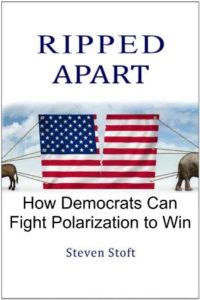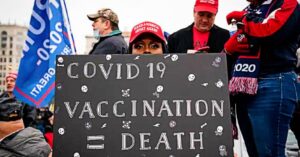4.3 What is Populism and
Why Should We Care?
In Republics, the great danger is that the majority may not sufficiently respect the rights of the Minority.
—James Madison, December 1829
Father of our Constitution and Bill of Rights
Unlike in the Johnny Cash song, Norman Williams never “shot a man in Reno just to watch him die.” But in 1982, Williams did burglarize a California apartment being fumigated. On the way out he himself was robbed at gunpoint. Even though he helped the police recover the stolen property, his burglary was strike one. A decade later, he stole some hand tools from an art studio, but when confronted by the homeowner, he dropped them and took off running. Strike two.
Then in 1997, he stole a floor jack from a tow truck. Strike three. Twelve years later, he was still literally “stuck in Folsom Prison” serving a life sentence under the harshest three-strikes law in the country. This populist three-strikes initiative had been passed by an overwhelming 72% of California’s voters.
Populism vs. the Founding Fathers
There was a time when citizens could not pass laws directly. That was before the Populist Party, organized in 1892, adopted the first party platform favoring state initiatives. But now most states allow initiatives—that’s direct democracy or what the Founding Fathers called “pure democracy.” The populist “will of the people” makes the rules.
Our Founding Fathers studied democratic institutions, starting with Greece, and decisively rejected this approach precisely because they knew it would lead to injustices like California’s three-strikes law. They did not mince words:
It has been observed that a pure democracy if it were practicable would be the most perfect government. Experience has proved that no position is more false than this. The ancient democracies in which the people themselves deliberated never possessed one good feature of government. Their very character was tyranny.
—Alexander Hamilton
James Madison, known as the father of the Constitution and the Bill of Rights, analyzed the situation at length before concluding:
In all cases where a majority are united by a common interest or passion, the rights of the minority are in danger.
Instead of imitating an ancient populist style of democracy, Madison advocated “a republic, by which I mean a government in which the scheme of representation takes place.” When it comes to passing laws, this is in direct opposition to the populist principle of one person, one vote. Only representatives can vote. (Of course, it is not in opposition to one person, one vote for electing representatives.) Madison also advocated the system of “checks and balances” between branches of government, which he viewed as a curb on the tyranny of populist majorities.
Norman Williams was saved by one of those anti-populist checks and balances when he was freed by a judge in April 2009, thanks to the efforts of Steve Cooley, a Republican district attorney from Los Angeles, and Michael Romano, founder of the Three Strikes and Justice Advocacy Project at Stanford Law School.
Populist Discrimination
Following the 1963 Rumford Fair Housing Act, which banned the racial discrimination in housing that kept Blacks in ghettos, the California Real Estate Association (CREA) immediately launched a populist repeal campaign. In November 1964, Californians voted two to one for an initiative (Proposition 14) that overturned the Fair Housing Act.
It wasn’t long before the California Supreme Court ruled Proposition 14 unconstitutional, and the U.S. Supreme Court agreed. That’s what checks and balances are for—reigning in populism.
Besides protecting racial minorities, checks and balances also protect political minorities. For example, in 2018, the Pennsylvania Supreme Court redrew Pennsylvania’s highly gerrymandered Congressional Districts that had strongly favored Republicans.
But the danger of populism is greater than it would seem from these examples. Its greatest danger is discussed by Alexander Hamilton in the first of the 85 Federalist Papers (October 1787):
Of those men who have overturned the liberties of republics, the greatest number have begun their career by paying an obsequious court to the people; commencing demagogues, and ending tyrants.
By December 2019, it had become clear that Trump is attempting the type of populist takeover that the Founding Fathers most feared. The greatest danger is from charismatic demagogues who court “the people.” This populist process is now threatening and compromising many democracies around the world. Although Hamilton’s observation gets to the heart of the problem, in practice, the variety of charismatic leaders can be confusing. Modern political science provides some clarity
How Can Populisms Look So Different?
Can Bernie Sanders and Donald Trump both be populists? One is a socialist, and the other, a capitalist of the first order.
It’s kind of like asking how a golf cart and a Tesla Model S can both be electric vehicles. They don’t have much in common, just an electric motor and wheels. It’s the same with populism. Populism is the “ism” of the people. So all populisms prioritize “the will of the people.” But that’s not all they have in common.
To see their commonalities, contrast populism with “liberal democracy”—one that protects the rights of minorities with representative government and checks and balances. Populism sees no need for such complexities because it imagines there is a single “will of the people” that should prevail. In other words, those who disagree with “the people” are simply wrong and don’t need the protections of checks and balances.
The result of this view is that, around the world, wherever populism is gaining strength, it is eating away at the protections provided by liberal democracies. Of course, we are seeing that right here at home, but it is worth noting how widespread this backsliding has become. So let’s take a quick look at the global populist wave that recently crashed on America’s shores.
The International Populist Wave
Populists took control in Italy in 1994; Venezuela in 1999; Turkey in 2003; Bolivia in 2006; Hungary in 2010; India in 2014; Greece and Poland in 2015; the United States in 2017; Italy (again) in 2018; and Brazil and England in 2019. There is no shortage of other populist parties on the move in Europe, so it appears that the populist wave does have real momentum.
The strange thing about this wave is the chaotic diversity of its leaders. In chronological order from 1994 to 2019, they are: a billionaire capitalist; a military socialist; an Islamist; a indigenous South-American socialist; an authoritarian nationalist; a Hindu supremacist; a radical leftist; a devout Catholic nationalist; a billionaire capitalist; a duo consisting of a left comedian and a right-wing nationalist; an authoritarian social conservative; and an Oxford-educated journalist. Despite the differences among these leaders, they all have something in common. That something is populism.
The Simplest Populism
Most societies have ended up with a few people being rich and powerful and the rest having little power or income. It’s not surprising then to find regular folks thinking the elite are corrupt, unfair, or in some way morally defective—especially because that view generally has quite a bit of truth to it.
Given these observations, the simplest imaginable view of the current unfair state of society from the perspective of ordinary people is:
- Society has two parts: the virtuous people (Us) and the corrupt elite (Them).
- The people want what’s right, and the “will of the people” should prevail.
That view is populism—in theory. But in the real world, what we call populism is always this view (call it basic populism) plus something more. This solves our original puzzle—how can Trump and Sanders both be populists? Sanders’ populism is roughly basic populism plus “socialism,” while Trump’s populism is akin to basic populism plus White nationalism.
I owe this definition of basic populism to Cas Mudde, a Dutch political scientist and a professor at the University of Georgia. He calls it “the thin ideology of populism,” but his concept is the same as what I call “basic populism.” The point is that by combining basic populism with various other “isms,” ideologies or worldviews—call them what you like—populist leaders can invent very different real-world forms of populism. And that is exactly what happens.
There can be socialist populism, progressive populism, racist populism, Muslim populism, green populism, libertarian populism and so on ad nauseam. The reason Mudde calls populism a thin ideology is because there’s not much to it. About all that populisms are guaranteed to have in common is a belief in Us as virtuous, Them as corrupt and that the will of the people should prevail. But these beliefs have important consequences.
Exclusionary Populism
As you may have already guessed, different types of populism define “the people” differently. Not understanding this is a major reason that left populists, who have a broad view of “the people,” get confused about Trump’s base.
Trump’s base excludes minorities and progressives from “the people,” and Trump signals that by calling his base “the real people.” Bernie Sanders includes everyone but the 1-percent richest and “establishment” politicians and calls this version of “the people” either “the 99%” or “the American people.” When political scientists want to talk about populism, they often talk about “the virtuous people,” but don’t take this too literally.
Unfortunately, the above definition of “basic populism” doesn’t cover Trump’s populism or most other right-wing populisms because it omits the possibility of excluded groups, such as immigrants. Such groups are neither part of “the people” nor part of “the elite.” So Trump’s type of populism—exclusionary populism—divides society into three groups, not two. The definition is easily fixed as follows:
New definition: Basic populism holds the following views:
- Society has two or three parts, the virtuous people (Us), the corrupt elite (Them) and possibly an out-group (also Them).
- The people want what’s right, and the “will of the people” should prevail.
Typically, in exclusionary (right-wing) populism, the people see the elite as being in cahoots with the out-group. For example, Trump’s populist movement sees the urban progressive elite as in cahoots with immigrants and Blacks—so they all are part of Them.
[Image: Trump being inaugurated]
Frame taken the instant Trump became President
WhiteHouse.gov
Pluralism Isn’t Populism
These days, every politician claims to be on the side of “the people.” Does that mean that every political ideology is some kind of populism? That would make the concept useless. But no, we have had only two truly populist presidents: Trump and Andrew Jackson. So there must be alternatives to populism. What are they?
Robber barons—members of the elite by any definition—are not often populists. They don’t tend to think the common people are virtuous or that they themselves are corrupt. Most likely they would think almost the opposite. So they tend to be elitists. Elitism is the most obvious alternative to populism.
Another non-populist worldview is more subtle. We may believe the elite are corrupt and the common people are virtuous, but we might not believe there is any such thing as “the will of the people.” Then we’re not populists. If instead, we believe that “the people” are composed of different groups with different views on what is right and just, then we likely believe that a central purpose of democracy is to find the best compromise among these groups. This is pluralism, not populism. And that is, of course, why we have a Republic with checks and balances.
If you look at the hodgepodge of identity groups recognized by the Democratic Party, it’s hard to believe there is a single “will of the people.” The Democrats and Republicans are, by nature, both pluralist parties.
This is a problem for populist leaders. But differences can be papered over by whipping up hatred of some outside group—bankers, billionaires, Muslims, Blacks or Mexicans—which is what populist leaders do. Still, pluralism is the most realistic view of the world. And it’s the safest because it rejects the polarizing Us-Them perspective.
Conclusion
Pluralism is the sensible alternative to populism. That is exactly the view that the Founding Fathers designed our Constitution to encourage and support. That design is now called liberal democracy because it protects a diversity of ideas and interests against the tyranny of some majority.
They knew their design was not perfect and, in fact, there were important things that many of them wanted changed even before the Constitution was ratified. One of these was an end to slavery. But they knew they could not get everything they wanted and that new problems would arise. So they built in flexibility.
The Constitution has since evolved towards a more populist structure, for example much broader voting rights and the direct election of senators. These changes have been for the better. But it would be a serious mistake to ignore the Founding Fathers’ warnings about the dangers of what we now call populism.
- Populism is an “Us versus Them” worldview.
- There is no “will of the people.”
- America was designed to prevent populism. We have “a republic, if we can keep it,” according to Ben Franklin.4.3

 Ripped Apart
Ripped Apart

